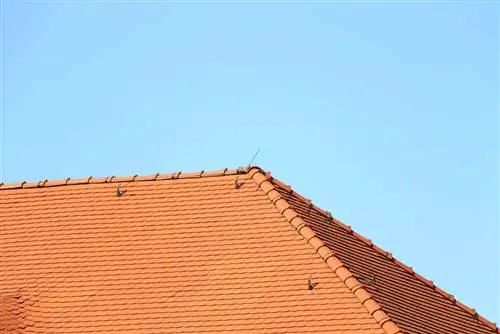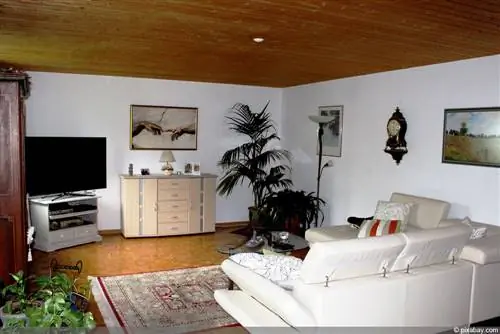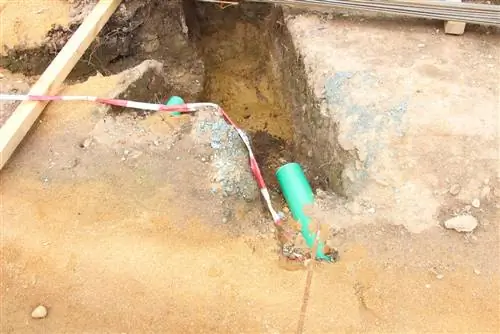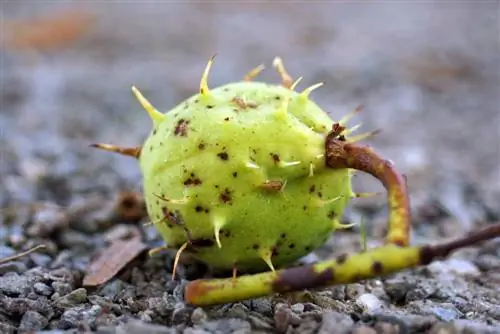- Author admin [email protected].
- Public 2023-12-17 03:39.
- Last modified 2025-06-01 06:48.
What should you cover the house gable with? This is the question asked by anyone who wants to protect, insulate or visually enhance the gable against the effects of the weather. Material costs, advantages and disadvantages of the respective type of cladding must be taken into account. We reveal what the differences are in the materials, which cladding variant is best suited for which use and what the material costs are.
Wood
Wooden gable cladding can be extremely versatile. Shingles or panels, horizontal or vertical, sawn or with smooth edges - wooden cladding offers numerous design options. So that the wooden facade on the gable is as durable as possible, offers protection and remains attractive, it must be protected accordingly. This means that the wood must be made more durable and protected using glazes or other processes.
Some types of wood, such as larch and oak, are already extremely weather-resistant. However, they should also be protected through preparatory procedures, such as painting. Otherwise they turn gray and can have a shortened lifespan due to weather influences. The material costs for a wooden facade depend on the type of wood - but are usually relatively high. For double-layer larch cladding, you can expect to pay around 60 euros per square meter.
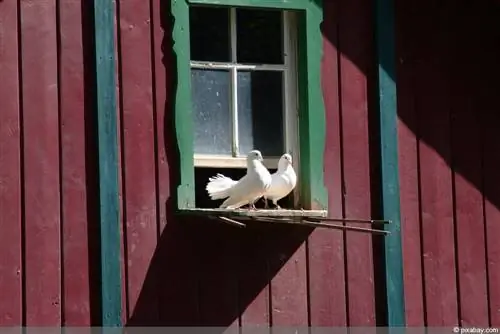
Advantages of wood cladding
- various variations possible
- natural raw material
- comparatively long lifespan
Disadvantages of wood cladding
- relatively expensive depending on the type of wood
- must be protected before attaching, for example with a glaze
- Protection refresh required at regular intervals
Plastic
Plastic cladding is just as versatile as wooden cladding. Different textures, shapes and colors are possible. The material is also very light in weight. Another advantage can be found in the material costs, which are significantly lower with gable cladding made of plastic than, for example, with expensive types of wood or slate cladding.
It is also positive that the elements for cladding are already coordinated with each other. This makes cladding the house gable very easy and can usually be done yourself. One potential disadvantage is that plastic can become porous over time when exposed to the elements and sun. Therefore, when purchasing, you should make sure that the plastic elements have a UV-stable top layer. The material costs for one square meter are on average around 20 euros.
Advantages of plastic cladding
- comparatively low costs
- great visual variety
- light weight
- easy to install
- easy cleaning, for example with a high-pressure cleaner
Disadvantages of plastic cladding
- Material can become porous due to sun and weather unless a UV-stable layer is applied
- not fire resistant
Slate
Providing the gable with slate makes sense if great value is placed on a natural and noble material. The sedimentary rock also offers convincing practical advantages. These include resistance to fire and frost, weather and aggressive environmental influences. This results in a long service life.
Although there is little scope for coloring, various forms of house gable cladding are now possible. One disadvantage, however, is that slate cladding can be comparatively expensive. Even for a very simple cladding variant made of slate shingles, you have to expect 25 to 50 euros per square meter.

Benefits of slate cladding
- Natural product
- very resistant to frost, fire, moisture and weather as well as other aggressive influences
- long lifespan
- appealing appearance
- wide variety of shapes available
Disadvantages of slate cladding
- little variation in terms of color
- comparatively high price
Eternit
Eternit is fiber cement. This is available in a wide range of finishes and can give the gable a very attractive and individual look. Grinded, profiled, colored through - many things are possible. Another advantage is that the cladding made from Eternit shingles or panels is extremely durable and resistant. It is also relatively inexpensive and only costs 15 to 20 euros per square meter for the double-layer version.
One disadvantage, however, is that, on the one hand, a substructure is often necessary for processing and installation and, on the other hand, special accessories are required. Unfortunately, this causes the price to rise significantly.
Advantages of Eternit cladding
- great design diversity, through different processing
- good insulating properties
- relatively low cost for the material itself
- high durability and long service life
Disadvantages of Eternit cladding
- high costs for accessories and installation
- Installation is relatively complex due to the necessary substructure
Aluminium
If the gable is covered with aluminum, numerous visual variations are possible. A lot is possible, from wood look to slate look. The material is also very light but durable, has good insulating properties and a long service life. UV rays, weather and other aggressive influences can hardly harm the light metal.
However, these benefits also come at a high price. Expect at least 200 euros per square meter for materials, accessories and substructure. Although the overall costs can be reduced somewhat by doing the installation yourself, the material itself is relatively expensive and has a similar cost to expensive types of wood.
Advantages of aluminum cladding
- numerous optical variations available
- very resistant to sun, weather and aggressive influences
- light in weight
- long lifespan
Disadvantages of aluminum cladding
- expensive material
- high total costs
Disguise Costs
The financial outlay for gable cladding is not limited to the material costs, which can vary greatly. The installation and accessory costs incurred must also be taken into account if a substructure and (additional) insulation have to be installed. The total costs also depend on whether the house gable is covered independently or whether a company is used.
As a rule, even with the cheapest material, you have to expect at least 50 to 100 euros per square meter when accessories and installation are taken into account. However, significantly higher prices are also not unusual.

